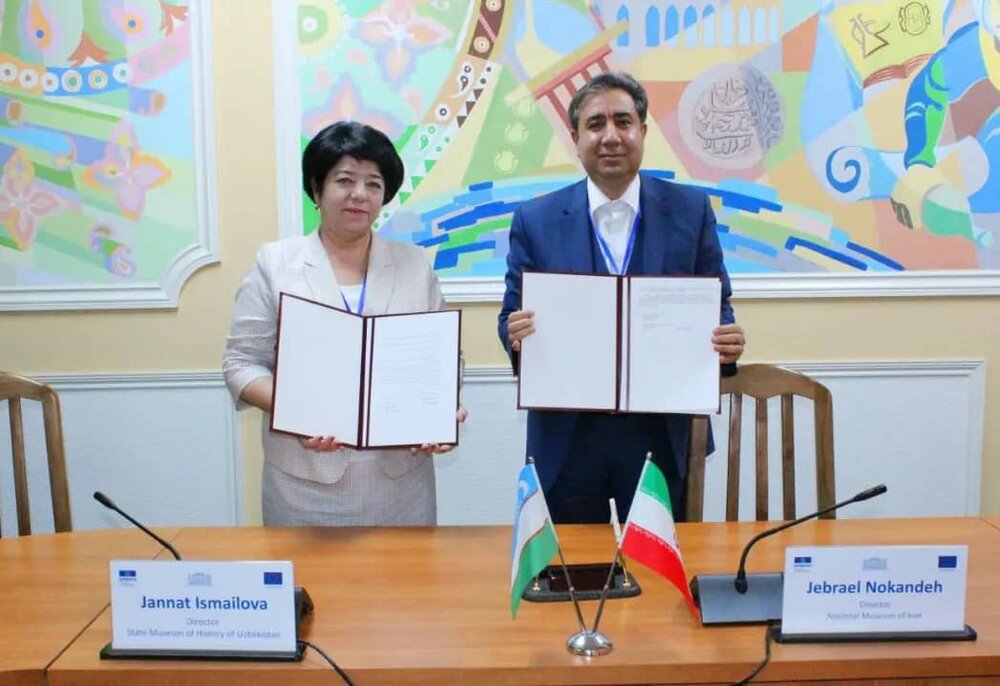Tehran, Tashkent museums call for robust cooperation

TEHRAN – The National Museum of Iran has reached an agreement with the State Museum of History of Uzbekistan to widen relations, organize loan exhibits and share expertise.
On Friday, National Museum of Iran Director Jebrael Nokandeh and his counterpart Jannat Ismailova, who presides over the State Museum of History of Uzbekistan, inked a memorandum of understanding in Tashkent.
The agreement is expected to help develop scientific and cultural ties such as research, cultural and educational projects between the two major museums, an official with the National Museum told Tehran Times on Sunday.
“Cooperation in the field of culture, history, art and museum activities; holding joint symposiums; organizing joint exhibitions; the exchange of specialists and joint publications are amongst other pillars of the argument,” the official explained.
This memorandum of understanding is valid for five years. It should be noted that the State Museum of History of Uzbekistan is under the auspices of the Uzbek Academy of Sciences, the official added.
The agreement was signed on the sidelines of the fourth working meeting of the joint exhibition on Common Heritage along the Silk Roads. The meeting was held by UNESCO in Tashkent on Thursday and Friday. In addition to the National Museum of Iran, the National Museums of Tajikistan, Kyrgyzstan, and Kazakhstan also signed a memorandum of understanding with the State Museum of History of Uzbekistan.
On the same day, the Iranian ambassador to Uzbekistan Hamid Nayyerabadi said the two countries have immense potential to broaden museum ties due to deep cultural and historical commonalities. “Deep cultural and historical commonalities between Iran and Uzbekistan has provided a rich ground for interactions between the museums of the two countries in holding cultural events and exhibitions,” Nayyerabadi said.
Nayyerabadi made the remarks on Friday during a meeting with Nokandeh at the embassy in Tashkent. Referring to the interest and desire of the government and people of the Republic of Uzbekistan to have more relations with Iran, Nayyerabadi said the two nations enjoy profound cultural and historical commonalities.
Furthermore, the Iranian envoy announced his readiness to help with the translation of the guidebook of the National Museum of Iran into Uzbek. This important reference of Iranian culture, art, and civilization has been translated into various languages such as English, Italian, Japanese, French, and German in addition to Persian.
Chock-full of priceless objects showcasing the juicy history of the nation, the National Museum showcases ceramics, pottery, stone figures, and carvings, mostly taken from excavations at Persepolis, Ismail Abad (near Qazvin), Shush, Rey, and Turang Tappeh to name a few.
Its main building, designed by French architect André Godard and completed in 1928, is one of the more attractive modern buildings in Tehran, blending Sassanian principles such as the grand iwan-style entrance with art deco–style brickwork.
Inside, among the finds from Shush, there’s a stone capital of a winged lion, some delightful pitchers and vessels in animal shapes, and colorful glazed bricks decorated with double-winged mythical creatures. A copy of the diorite stele detailing the Babylonian Code of Hammurabi, found at Shush in 1901, is also displayed – the original being in Paris.
Exhibits from Persepolis include a magnificent human-headed capital, a cuneiform inscription proclaiming the might and godly affinity of Xerxes, and a striking frieze of glazed tiles from the central hall of the Apadana Palace. Also on display are a famous trilingual inscription from the time of Darius I, a bull-headed capital and carved staircase, a statue of a sitting dog that looks like it was carved just weeks ago, and four foundation tablets inscribed in cuneiform.
One of the more startling exhibits is the Salt Man from Zanjan. He is estimated to have been a miner who died in the 3rd or 4th century CE, but whose white-bearded head, leg in a leather boot, and tools were preserved by the salt in which he was buried.
AFM
Leave a Comment